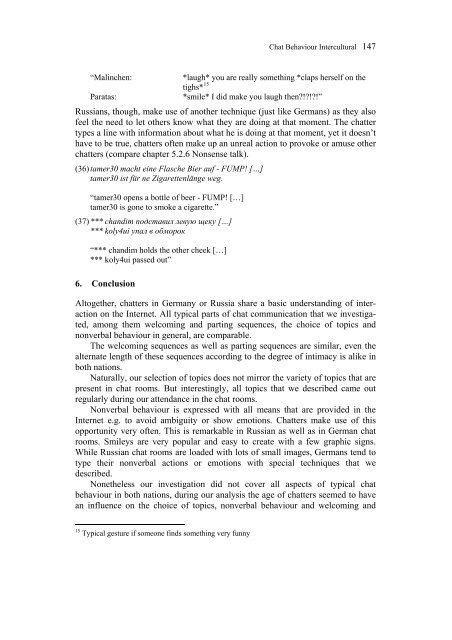Dialogue in and between Different Cultures - International ...
Dialogue in and between Different Cultures - International ...
Dialogue in and between Different Cultures - International ...
You also want an ePaper? Increase the reach of your titles
YUMPU automatically turns print PDFs into web optimized ePapers that Google loves.
Chat Behaviour Intercultural 147<br />
“Mal<strong>in</strong>chen: *laugh* you are really someth<strong>in</strong>g *claps herself on the<br />
tighs* 15<br />
Paratas: *smile* I did make you laugh then?!?!?!”<br />
Russians, though, make use of another technique (just like Germans) as they also<br />
feel the need to let others know what they are do<strong>in</strong>g at that moment. The chatter<br />
types a l<strong>in</strong>e with <strong>in</strong>formation about what he is do<strong>in</strong>g at that moment, yet it doesn’t<br />
have to be true, chatters often make up an unreal action to provoke or amuse other<br />
chatters (compare chapter 5.2.6 Nonsense talk).<br />
(36) tamer30 macht e<strong>in</strong>e Flasche Bier auf - FUMP! […]<br />
tamer30 ist für ne Zigarettenlänge weg.<br />
“tamer30 opens a bottle of beer - FUMP! […]<br />
tamer30 is gone to smoke a cigarette.”<br />
(37) *** ch<strong>and</strong>im подставил левую щеку […]<br />
*** koly4ui упал в обморок<br />
“*** ch<strong>and</strong>im holds the other cheek […]<br />
*** koly4ui passed out”<br />
6. Conclusion<br />
Altogether, chatters <strong>in</strong> Germany or Russia share a basic underst<strong>and</strong><strong>in</strong>g of <strong>in</strong>teraction<br />
on the Internet. All typical parts of chat communication that we <strong>in</strong>vestigated,<br />
among them welcom<strong>in</strong>g <strong>and</strong> part<strong>in</strong>g sequences, the choice of topics <strong>and</strong><br />
nonverbal behaviour <strong>in</strong> general, are comparable.<br />
The welcom<strong>in</strong>g sequences as well as part<strong>in</strong>g sequences are similar, even the<br />
alternate length of these sequences accord<strong>in</strong>g to the degree of <strong>in</strong>timacy is alike <strong>in</strong><br />
both nations.<br />
Naturally, our selection of topics does not mirror the variety of topics that are<br />
present <strong>in</strong> chat rooms. But <strong>in</strong>terest<strong>in</strong>gly, all topics that we described came out<br />
regularly dur<strong>in</strong>g our attendance <strong>in</strong> the chat rooms.<br />
Nonverbal behaviour is expressed with all means that are provided <strong>in</strong> the<br />
Internet e.g. to avoid ambiguity or show emotions. Chatters make use of this<br />
opportunity very often. This is remarkable <strong>in</strong> Russian as well as <strong>in</strong> German chat<br />
rooms. Smileys are very popular <strong>and</strong> easy to create with a few graphic signs.<br />
While Russian chat rooms are loaded with lots of small images, Germans tend to<br />
type their nonverbal actions or emotions with special techniques that we<br />
described.<br />
Nonetheless our <strong>in</strong>vestigation did not cover all aspects of typical chat<br />
behaviour <strong>in</strong> both nations, dur<strong>in</strong>g our analysis the age of chatters seemed to have<br />
an <strong>in</strong>fluence on the choice of topics, nonverbal behaviour <strong>and</strong> welcom<strong>in</strong>g <strong>and</strong><br />
15 Typical gesture if someone f<strong>in</strong>ds someth<strong>in</strong>g very funny



